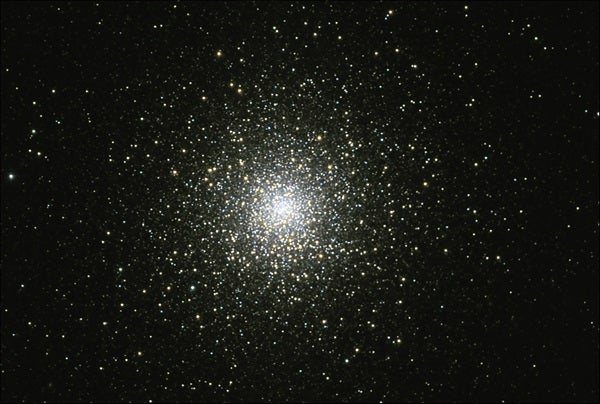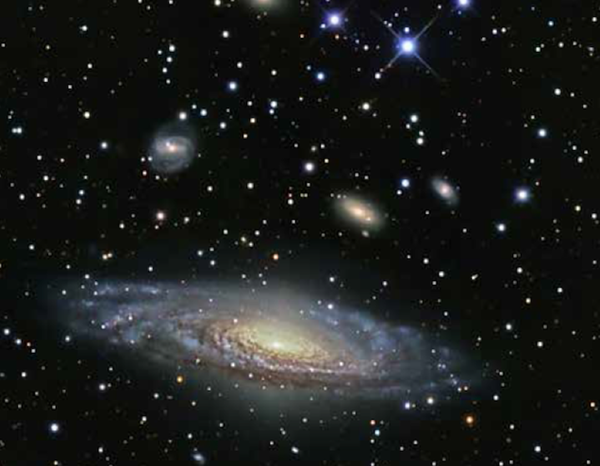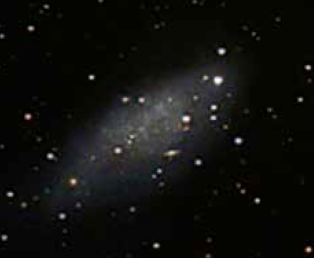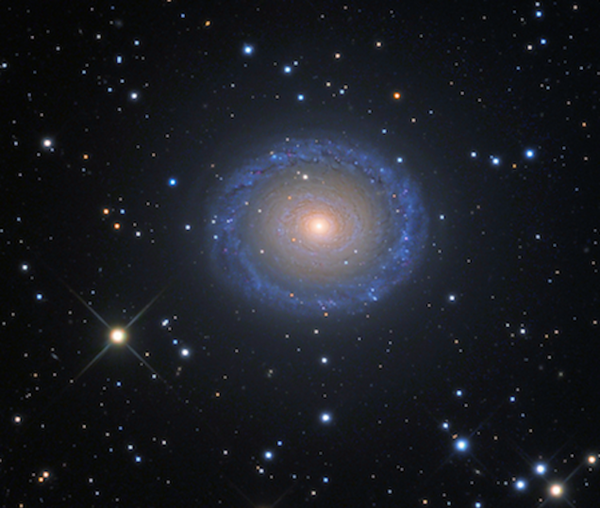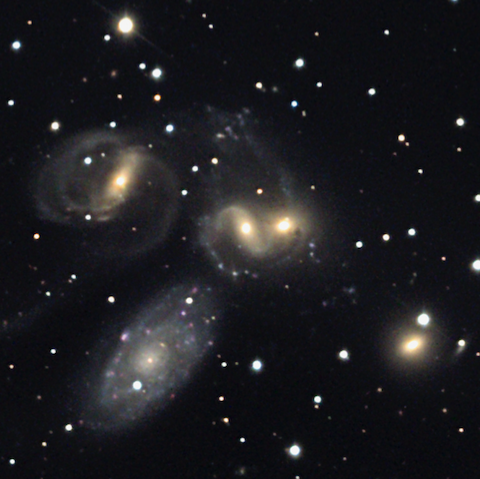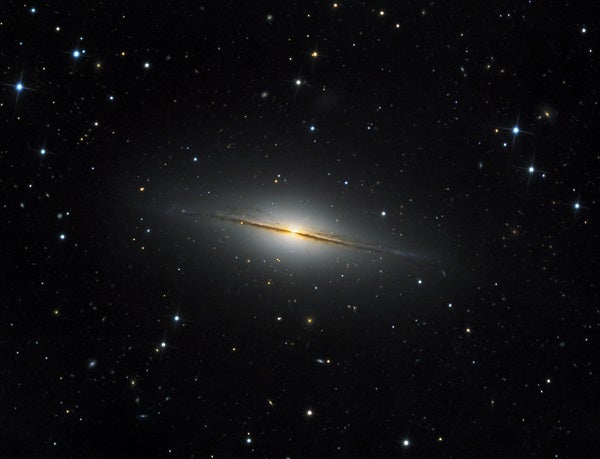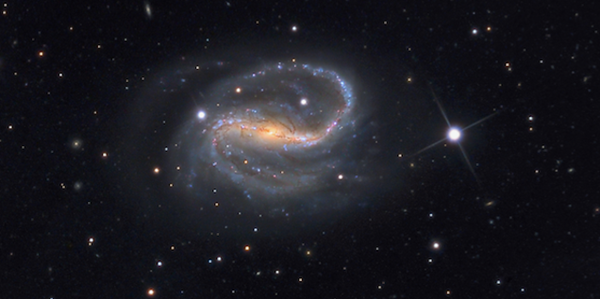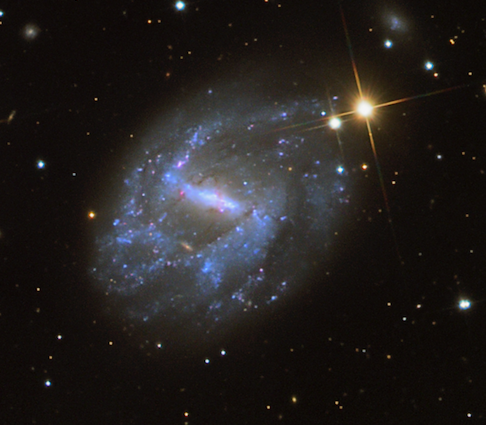From the northern latitudes where most amateur astronomers live, Pegasus climbs much higher. In fact, its central point in declination lies 30° farther north than that of Cetus. So, not only is the Horse easier to see, but its stars also lie far above the horizon, where the thick air distorts the view.
The most recognizable part of Pegasus is the Great Square, an asterism made up of four stars: Markab (Alpha [α] Pegasi), Scheat (Beta [β] Peg), Algenib (Gamma [γ] Peg), and Alpheratz (Alpha Andromedae) marking the northeast corner. Yes, Andromeda. Nobody said given names in observational astronomy were logical.
But I’ll try to be logical in the way I lead you to the objects. Let’s start at the western end of the constellation and move eastward. That way, if you begin observing when the first object is high in the sky, the other objects will literally rise into their best viewing positions.
Permit me to suggest a couple of tips. First, dress warmly, preferably in layers. You can always take a jacket or sweatshirt off. I don’t recall ever feeling too hot to observe, but I’ve frozen on many a night when temperatures were “moderate.” Remember, you’re not doing anything but looking. Second, sit in a chair whose height places your eye near the eyepiece. Remember: Comfort is everything.
Our first target is Pegasus’ odd duck. It’s the only object on this list that’s not a galaxy. M15 ranks as autumn’s showpiece globular cluster for Northern Hemisphere observers. From a dark site, those with sharp vision can spot this magnitude 6.2 object with their naked eyes. Don’t be confused by the magnitude 6.1 star only 17′ to the east. Confirm your sighting through your telescope. M15 has a diameter of 12.3′.
And speaking of telescopes, a 4-inch scope will resolve dozens of stars around M15’s strikingly bright core. Look for the chains of stars that wind out from its center. These star patterns cause some observers to describe M15 as slightly oval.
Finding M15 is pretty easy. Use Theta (θ) and Epsilon (ε) Pegasi as pointers. Draw a line from Theta through Epsilon, and continue another 4°.
With a 10-inch or larger telescope, try for the challenge object within M15: Pease 1, the first planetary nebula found within a globular cluster. In 1928, American astronomer Francis Gladheim Pease discovered this object when he noticed an unusually bright “star” on a photographic plate taken with the 100-inch Hooker Telescope on Mount Wilson.
Look for this planetary nebula through an eyepiece that yields 200x or so, and use a nebula filter to suppress the brightness of the myriad stars surrounding Pease 1. Be aware of the sky conditions. You’ll need good seeing to spot the tiny planetary, which lies about 1′ northeast of M15’s core.
You’ll see more detail as you observe through ever-larger telescopes — a mantra of amateur astronomy called “aperture rules.” Few celestial objects demonstrate this better than our next target, Stephan’s Quintet.
French astronomer Édouard Stephan discovered this group in 1877. The five galaxies now carry the designations NGC 7317, NGC 7318A, NGC 7318B, NGC 7319, and NGC 7320.
Four of these galaxies — the exception being NGC 7320 — form a compact galaxy group, the first ever discovered. NGC 7320 belongs to the Pegasus Spur, a group of about three dozen galaxies, the brightest of which is magnitude 9.5 NGC 7331, which you’ll read about later.
Although you can “see” Stephan’s Quintet from a dark site through a 6-inch scope, a magnification of 50x will show you only a faint, clumpy glow 3′ across. A 12-inch telescope, on the other hand, lets you identify the individual members.
The brightest and largest member, NGC 7320, lies to the southeast and contains a 13th-magnitude foreground star in its halo. This galaxy shines at magnitude 12.6. NGC 7319, which sits at the group’s northeastern edge, is the real test for visual observers. It glows softly at magnitude 13.1.
Deep-sky objects have some fanciful names, but usually they fit the view. For example, the Blue Snowball (NGC 7662) in Andromeda is blue and round; the Omega Nebula (M17) in Sagittarius looks like that Greek letter; and Gomez’s Hamburger (IRAS 18059–3211), also in Sagittarius, looks like a sandwich.
But what’s the story behind our next deep-sky object, the Deer Lick Group? In the 1980s, American amateur astronomer Tom Lorenzin bestowed the common name on this galaxy group to honor the Deer Lick Gap in the mountains of North Carolina. Apparently, Lorenzin had a memorable view of these galaxies from there.
The Deer Lick Group’s brightest member is NGC 7331. Under a dark sky, you can spot this magnitude 9.5 spiral through binoculars. It measures 10.5′ by 3.7′, making it one-third the width of the Full Moon. Through a 10-inch scope with a low-power eyepiece, you’ll see three galaxies to the east of NGC 7331 that form an equilateral triangle. These galaxies are not NGC 7331’s companions, but instead lie much farther away.
I’m certain you’ll enjoy our next object, or should I say pair of objects? NGC 7332 and NGC 7339, just 5′ to its east, form a gorgeous pair of lens-shaped galaxies only 2.1° west of magnitude 4.0 Lambda (λ) Pegasi. NGC 7332 glows at magnitude 11.1 and measures 3.7′ by 1.0′.
Both objects’ lengths are triple their widths. Each has even illumination, but NGC 7332’s core is a bit broader. You can tell them apart mainly by their brightnesses; NGC 7339 glows more faintly than its neighbor, at magnitude 12.2.
The next galaxy on my list is mainly for amateurs with large scopes. NGC 7457 is a spiral galaxy 2.1° north-northwest of Scheat. It glows softly at magnitude 11.2 and measures 4.1′ by 2.5′. Through an 8-inch telescope, it appears nearly rectangular, twice as long as it is wide, and oriented northwest to southeast.
If you were a bit disappointed by NGC 7457, allow me to make it up to you. NGC 7479 is a showpiece galaxy through a large scope; it lies 2.9° south of Markab. A 10-inch telescope shows the barred spiral galaxy’s odd structure.
Now head 2.6° northwest of magnitude 4.3 Theta Piscium to find the giant elliptical galaxy NGC 7626. It and its near-twin, NGC 7619, which lies just 7′ to the west, are the brightest members of the Pegasus I galaxy cluster.
Despite being nearly 200 million light-years away, the two glow at magnitude 11.1. An 8-inch telescope shows each galaxy as a bright core immersed in a featureless halo. Both galaxies look slightly oval, measuring roughly 2.5′ by 2.0′.
Next is another deep-sky treat that disproves the notion that you’ll find nothing within Pegasus’ Great Square. NGC 7678 lies 1.2° southeast of magnitude 4.4 Upsilon (υ) Pegasi. It glows at magnitude 11.3 and measures 2.3′ by 1.7′. This face-on spiral has tightly wrapped arms that only begin to reveal themselves through 14-inch scopes at high power. As you observe this object, note the isosceles triangle of 12th-magnitude stars that frame NGC 7678.
Everyone likes a challenge, right? Our next target, the Pegasus Dwarf (UGC 12613), isn’t bright, but you should seek it out. Lying just below the Great Square, the Pegasus Dwarf is one of the most distant members of our Local Group of galaxies. At a distance of 5.7 million light-years, it sits a bit more than twice as far from us as the Andromeda Galaxy (M31).
As we continue our eastward trek through Pegasus, we come to the barred spiral galaxy NGC 7741. The easiest way to find it is to look 6.2° west-southwest from Alpheratz. The galaxy glows at magnitude 11.3 and measures 4.0′ by 2.7′.
This target requires an 8-inch telescope to reveal its details. At 100x, NGC 7741 appears as a mottled, round haze. Move up to 250x, and you’ll see the uniformly lit bar that extends east to west across the glow. Apertures of 18 inches or more show hints of the faint surrounding spiral arms.
A nice double star consisting of magnitude 9.8 GSC 2254:1685 and magnitude 11.9 GSC 2254:1349 lies at the northern edge of the halo and points to the galaxy’s core. They’re separated by about 20″.
Our next target lies 2.6° west-northwest of magnitude 2.8 Algenib, and it’s a good one: the magnitude 10.6 spiral galaxy NGC 7814. Small telescopes reveal this object’s football shape (6.0′ by 2.5′), but with more tapered ends. The central region spans a third of NGC 7814’s length.
This galaxy does have a prominent dust lane captured by many astroimagers. You’ll need a huge telescope to have even a slight chance to see it, however. Through a 20-inch scope, crank the magnification past 400x, and look for two thin lines that emanate from points outside the core and cross the galaxy’s long axis.
I started this list with a bang (a naked-eye object), so I guess it’s OK to end with a whimper. Those of you with 8-inch or larger telescopes who observe under a dark sky can search for spiral galaxy NGC 1. It’s pretty small, measuring 1.7′ by 1.2′.
I like pointing this object out to fellow amateur astronomers because few have seen the very first object in the New General Catalogue. Although NGC 1 lies in Pegasus, it sits really close to the constellation’s border with Andromeda.
Look for this magnitude 12.9 object 1.4° south of bright Alpheratz. Don’t expect to see much detail, but, hey, at least you can say you’ve observed the NGC’s first object.
As you observe NGC 1, avert your gaze less than 2′ south, and try to spot another faint spiral galaxy, NGC 2. At magnitude 14.2, this object poses more of a challenge than NGC 1. NGC 2 measures 1′ by 0.6′.
Observing the many galaxies in Pegasus is such a rewarding pursuit, especially when you seek out a dark site, use at least a medium-size scope, and exercise patience to coax out the great details you’ll see.

